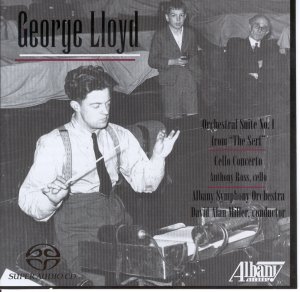The later symphonies of George Lloyd have always rung
somewhat hollow to me. The manner of the great works (symphonies 4-8)
is there but the exultant spark is absent or at the very least gutters
and flickers. I found similar problems (possibly mine) with the piano
concertos.
The works on this disc are from different ends of his
career and they are prime Lloyd. The Cello Concerto, despite
being a late work, recaptures his quintessential and captivating flow
of ideas and treatment unembarrassed by anachronism. The playing is,
I think, all that the composer might have wished though the Albany's
violins can sound a mite glassy (as at 2.03 tr3). This is a concerto
that stands in the proud line represented by the Dvořák,
the Elgar and the Finzi.
The Concerto is in one movement though blessedly banded
on this disc in seven sections: 1. violante, doloroso (smacks
of the style of Kodaly's solo cello sonata with some lovely tremulous
pianissimi); 2. Vivo (Elgar and some ineffably romantic strokes
as at 4.30); 3. Adagio (very Sibelian/Tchaikovskian and close
to the joie de vivre of Lloyd's chef d'oeuvre, his Sixth Symphony);
4. Andante (elegiac, yet more Sibelian string writing, Elgarian);
5. Vivo (bright eager woodwind skip and skim around the cello's
swallow-tailed flight line - some supple, velour-toned string writing
and playing); 6. Moderato; 7. Largo (no conventional high
jinks but an ineluctably sincere farewell, sounding a little like the
slow movement from the Moeran Symphony and instantly memorable for the
hollow drumbeat that tolls arhythmically through the slow descent into
silence and darkness - an ave atque vale that confounds all need
for flourishes and fireworks). The sepulchral beat of the drum recalls
the valedictory drum-line in the epilogue of Bax's Sixth Symphony. That
last movement is extremely impressive and affecting. When the muted
din around Lloyd has subsided I am sure that this work will be counted
amongst the strongest of his output. It is without a doubt the best
of his concertos.
This is a lovingly balanced, imagined and performed
elegiac work. It has only a momentary grip on vivacity, joy and excitement.
The fact that it ends with a moderato and then a largo
says much for its reflective, and I must say irresistible, downbeat.
The Serf, is one of Lloyd's three operas; the
others being Iernin and John Socman. It is the work of
a man of 25, his second opera (the first being Iernin) premiered
at the Royal Opera House, Covent Garden in 1938.
The movements are: 1. Woodlands (evocative of
a cathedral of trees, sacerdotal in mood); 2. Sigrid's Fear (tension,
a Verdian breadth and fall to the melody; a touch of Rota's Romeo
and Juliet long before Rota, of course, and even a warming, slightly
sorrowing breath from Miaskovsky); 3. Love Duet (a Baxian ochre-tone
sets the scene over which develops an emotional dialogue catching half-lights
and reflections from the Moeran Symphony, from Howard Hanson's love
music in the Merry Mount opera, and from Vaughan Williams' Sir
John in Love); 4. Deciso (something of the vivo sections
of the Sixth Symphony); 5. Sicily (tragic and reflective); 6.
Fate (a potently oppressive eldritch Baxian atmosphere); 7. Outrage
(a gripping on-the-edge-of-seat scherzo with a shadow of the Dies
Irae putting in an appearance; it being 1938 we might be forgiven
for catching an augury of Poland and a glimpse or two of Guernica).
The plot of The Serf has about it something
of Sibelius's Kullervo. This too has the hapless lovers, Sigrid
and Cerdic, discovering that they are brother and sister. The destructive
Robert de Fulke covets Sigrid for his own and when the two take to the
road he pursues them but is killed. The two lovers take their own divergent
paths - tragically bereft. Their resigned farewells resound stoically
through a tawny twilight. The Bible-black violence of the closing bars
can be seen as predictive of the horrors and callousness Lloyd was to
suffer in the then impending world war.
This is a hybrid multi-channel SACD disc also playable
on standard CD players. I can only comment on the conventional CD performance
which sounded excellent to me.
The notes are good though light on hard facts such
as precise dates and details of premieres and in the case of the opera
denying us details of the original cast, choir etc. A nice touch though
was to remind us that copies of the libretto of The Serf were
available from Albany Records (UK) at Box 12, Warton, Carnforth, Lancs
LA5 9PD. 01524 735873. fax 01524 736448.
Lloyd on resoundingly confident form. Place it alongside
symphonies 5, 7 and 8.
Rob Barnett


